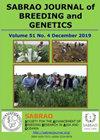水稻数量性状遗传参数及主成分分析
IF 1.7
Q3 PLANT SCIENCES
引用次数: 0
摘要
常规育种对提高产量性状和培育高产品种至关重要。在本研究中,对15个F1杂交种进行了评价,比较了它们与6个亲本基因型的各种性状的遗传变异。结果表明,杂交组合与亲本品种之间、亲本与杂交品种之间、差异极显著(P≤0.01)。亲本与杂交的平方和均显著(P≤0.01)。F1代各性状的一般配合力(GCA)和特异配合力(SCA)方差均极显著(P≤0.01)。Sakha108、Giza179和Sakha109对籽粒产量株系1呈极显著正相关,这意味着这些品种可以作为优良的配合者在育种计划中转移上述性状。配合力下,7个杂交株高为负,为避免倒伏,适宜机械收获;然而,在其他性状中,正显著值更可取。结果表明,Sakha105 × Sakha102、Sakha105 × Sakha108和Sakha108 × Sakha109是产量和株高最好的杂交组合。聚类分析显示基因型可分为四组。第一组包括水稻基因型Sakha109和Sakha108。这些品种均为Sakha101亲本,在旗叶面积、千粒重和穗重3个数量性状上具有亲缘关系。第二组,包括Sakha 102和Sakha 106,有非常相似的遗传背景,因为这两个品种有一个共同的亲本,吉萨177。此外,两个品种分蘖数、千粒重和穗数均相当。第三组只包括属于籼粳品种的吉萨179。第四组是由不同父母所生的Sakha 105。本文章由计算机程序翻译,如有差异,请以英文原文为准。
GENETIC PARAMETERS AND PRINCIPAL COMPONENT ANALYSIS FOR QUANTITATIVE TRAITS IN RICE (ORYZA SATIVA L.)
Conventional breeding is vital in improving yield-related traits and developing high-yielding cultivars. In the presented study, an evaluation of 15 F1 hybrids compared them to their six parental genotypes for genetic variation of various traits. The results showed that the analysis of variance revealed significant (P ≤ 0.01) differences among the cross combinations and parental cultivars and among the parents and crosses. The mean sum of squares of parents vs. crosses also indicated substantial (P ≤ 0.01) for all the characteristics. The general (GCA) and specific combining ability (SCA) variances were significant (P ≤ 0.01) for all traits studied in the F1 generation. Three varieties, namely, Sakha108, Giza179, and Sakha109, were highly significantly positive for grain yield plant-1, which means these varieties can benefit as good combiners to transfer the said trait in the breeding program. In SCA, seven crosses were negative in plant height and a negative value was desirable to avoid lodging and suitable for mechanical harvesting; however, positive significant values are preferable in the rest of the traits. The results indicated that the best crosses for grain yield plant-1 and plant height were Sakha105 × Sakha102, Sakha105 × Sakha108, and Sakha108 × Sakha109. Conducting cluster analysis also exhibited the genotypes dividing into four groups. The first group included rice genotypes Sakha109 and Sakha108 alone. These cultivars, produced from a common parent Sakha101, could have genetic relations for three quantitative traits (flag leaf area, 1000-grain weight, and panicle weight). The second group, comprising Sakha 102 and Sakha 106, has a very similar genetic background because both cultivars share a common parent, Giza 177. In addition, these two rice cultivars had at par number of tillers plant-1, 1000-grain weight, and panicles plant-1. The third group included only Giza 179 belonging to Indica-Japonica varieties. A fourth group has Sakha 105 produced by different parents.
求助全文
通过发布文献求助,成功后即可免费获取论文全文。
去求助
来源期刊

Sabrao Journal of Breeding and Genetics
农林科学-奶制品与动物科学
CiteScore
1.90
自引率
50.00%
发文量
63
期刊介绍:
The SABRAO Journal of Breeding and Genetics is an international journal of plant breeding and genetics research and was first published in 1969. It is the official publication of the Society for the Advancement of Breeding Research in Asia and Oceania (SABRAO).
Its objectives are to: promote the international exchange of research information on plant breeding and genetics, by describing new research findings, or ideas of a basic or practical nature; and be a medium for the exchange of ideas and news regarding members of the Society.
The Journal gives priority to articles that are of direct relevance to plant breeders and with emphasis on the Asian region. Invited for publication are research articles, short communications, methods, reviews, commentaries, and opinion articles. Scientific contributions are refereed and edited to international standards.
The journal publishes articles for SABRAO members mainly. The Journal preferred strongly that at least one author should be a current member of the Society. Non-members may also publish in the journal.
 求助内容:
求助内容: 应助结果提醒方式:
应助结果提醒方式:


